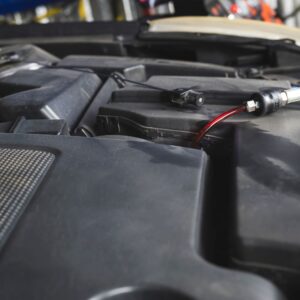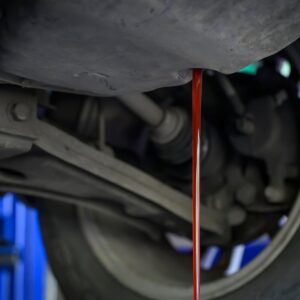What’s the Definition of a Transmission Fluid Exchange?
A transmission fluid exchange replaces all the fluid in the transmission rather than just what’s in the transmission pan.
The process goes beyond simply removing the transmission oil pan and replacing the filter. It requires a machine to be connected between the cooler line and the transmission cooler. The machine intercepts the fluid leaving the transmission from the cooler line while feeding new fluid from a separate tank into the cooler and back to the transmission.

This method also replaces all the fluid in the torque converter. But even after the machine has done its work, the pan should be removed and the filter should be replaced and then the transmission should be topped off with fluid.
Together with other maintenance services, transmission fuel exchanges help keep the transmission in good shape. The benefits extend to the rest of the vehicle. Smoothly shifting between gears reduces the wear on various parts, such as the braking system and suspension.
Why Does Your Vehicle Need a Transmission Fluid Exchange?
Transmission fluid replacement benefits the vehicle. However, you must perform the appropriate procedures and add a suitable transmission fluid.
A transmission fluid exchange is highly recommended if the lubricant shows clear signs of heavy contamination or degradation. If it is dark brown and smelly or milky looking due to coolant or water contamination, the fluid should be replaced. In the case of milky fluid, the transmission cooler in the radiator (when equipped that way) is suspect unless the person has driven through a lot of high water so that water entered through the vent.
If the transmission fluid is dark brown and smelly or milky looking due to coolant or water contamination, the fluid should be replaced. In the case of milky fluid, the transmission cooler in the radiator (when equipped that way) is suspect unless the person has driven through a lot of high water so that water entered through the vent.
– Richard McCuistian, ASE Certified Master Automobile Technician
The transmission type also determines how much the vehicle will benefit from transmission fuel exchanges. In manual transmissions, a conventional drain and refill process removes only a third to a half of the transmission fluid in an automatic transmission. While a transmission fluid exchange brings benefits, manual transmissions don’t need it very often.
Performing a transmission fluid exchange on an automatic transmission removes practically all of the old and dirty lubricant, replacing it with fresh fluid.
What Is Transmission Fluid?
Transmission fluid is both a hydraulic fluid that applies the clutch packs that drive planetary gear elements to provide the different gear ranges, and ialso a lubricant and a coolant that protects transmission gears and clutch packs.
What Does Automatic Transmission Fluid Do For Your Car?
Automatic transmission fluid performs several major roles in your vehicle’s transmission. First, it is delivered under pressure to the torque converter, which provides the fluid coupling and the same fluid pressure is also delivered to the valve body where shift solenoids and spool valves direct the fluid to servos, brakes, and clutch pistons inside the transmission.
These components either drive or hold planetary gear elements to provide the different gear ratios. The fluid also reduces friction between gears and other moving parts and keeps them cool, although most of the heat created in an automatic transmission is generated in the torque converter.
What Makes Transmission Fluid Go Bad?
The lubricant gradually degrades and accumulates contaminants. A transmission that is used to pull heavy loads will need more frequent fluid changes due to the way heat changes the properties of the fluid. Old fluid will deposit varnish on valve body spool valves and cause the transmission to misbehave.
Contaminants are another frequent reason for the transmission fluid going bad. Dirt and water can enter the transmission through leaks and openings. Furthermore, gears and other moving parts might scrape small particles off metal surfaces, especially if there isn’t enough transmission fluid coating the surfaces. The debris created by metal-on-metal contact often ends up collected by the transmission fluid.
Wherever the contaminants come from, they’re not supposed to appear in the transmission. They make the transmission fluid dirty and less capable of absorbing heat and lubricating moving parts.
Bad transmission fluid forces the transmission to compensate for its shortcomings by working harder. Overworked transmission parts wear out faster and develop issues more frequently.
Old and dirty transmission fluid can lead to issues like slipping gears, poor shifting, and transmission failure. You need to regularly change the transmission fluid if you want the transmission to keep running like it should.
When Should You Perform a Transmission Fluid Exchange?
Fluid change intervals vary according to your vehicle’s make and model, the driving conditions you usually encounter, and what the manufacturer advises. Automatic transmissions also have different recommended intervals compared to manual transmissions.
Some vehicles can go 100,000 miles before needing a transmission fluid exchange. Other vehicles require fresh fluid every 15,000 miles.
One problem with doing a transmission fluid change on a transmission that has been driven hard for over 100,000 miles is that the new fluid can wash baked on varnish off of spool valves and other parts and cause those valves to stick in their bores. In other words, if you wait too long to have a transmission service done, your transmission may develop issues it didn’t have before the service, and you can’t blame the shop that did the service.
Harsh driving conditions can shorten the recommended interval between transmission fluid exchanges. For example, driving in stop-and-go traffic requires you to constantly shift gears, generating more heat that degrades the transmission fluid.
Towing is another condition that forces the transmission to work harder and hotter. Since the trailer lacks a transmission, the towing vehicle must compensate for what’s effectively deadweight when shifting between gears.
Do you often drive through floods? Water can seep into the transmission through a bad seal. Transmission fluid will go bad if it comes into contact with moisture and dirt.
Check your owner’s manual for the transmission fluid exchange schedule recommended by the manufacturer. Stick to that schedule as closely as possible.
Regular transmission fluid exchanges help keep your vehicle in good shape and extend its overall service life. They’re well worth the time and cost, especially if you drive an automatic car.
Any information provided on this Website is for informational purposes only and is not intended to replace consultation with a professional mechanic. The accuracy and timeliness of the information may change from the time of publication.

































